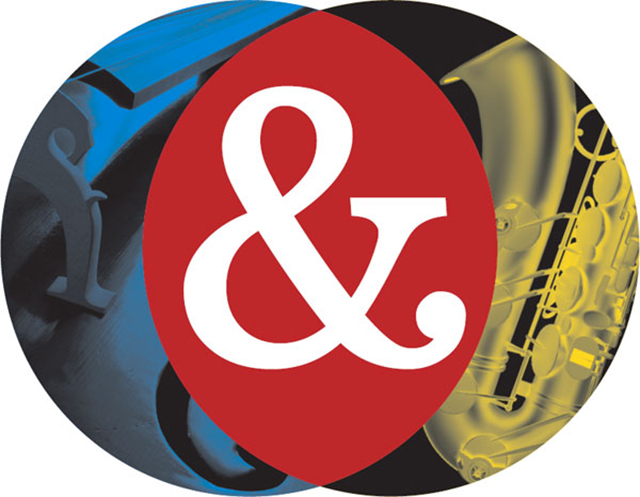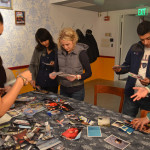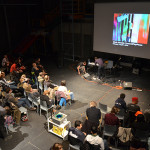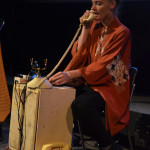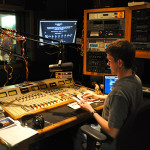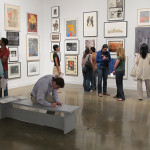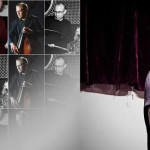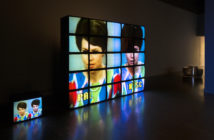The essence of MIT's success is clear in its motto: Mens et Manus, mind and hand. Traditionally known for its research and education in science, technology, and engineering, MIT has continued to aggressively push development in its various schools and across disciplines, including the arts and humanities. Students and faculty are challenged to be both thinkers and educators in the world of academia, and also doers and creators out in society, in business and culture.
In the spirit of MIT, the List itself has become an incubator for research and development in the visual arts. In addition to a robust calendar of consistently excellent exhibitions, the List also manages a world-class public art collection, the annual Student Loan Art Program, and a host of residencies and collaborations with leading artists at the forefront of art research and production.
Upon his appointment as Director of the List in 2011, Paul Ha took it upon himself and his team to open up the List and grow its local audience into the internationally renowned reputation it has always hosted beyond Cambridge and Boston. Cue in 2012 the hiring of the List's first Campus and Community Outreach Coordinator, Courtney Klemens. Since then, an ongoing rebranding project has unveiled a new List logo and will introduce a website redesign in the later spring of 2014. The goal is to crystallize the List’s identity as a leading contemporary art museum.
When Elliot Avila and Yurij Lojko, general manager and engineer, respectively, at WMBR, approached the List about hosting a collaborative concert series, Klemens thought it was a natural fit. "I listen to WMBR, and I think they do really great programming," Klemens explains. "The idea they were proposing was very attractive, because there is a lot of natural overlap between the membership and listeners of WMBR and the audiences that we want to grow at the List." The series was developed not only as a means of expanding the audience base, but as "a program where you could see how different arts reflect one another; where they're influencing each other and taking a little bit away."
The brainchild of Avila and Lojko, Ampersand was soon joined by Tim Gilman, another engineer and community member at WMBR, as its co-producer and project manager. Lojko, who built and maintains the Ampersand website and manages promotional efforts, also "moonlights" by day as a Senior UI Developer at Genuine Interactive, a digital marketing agency in the South End. Gilman is a technician at WGBH Boston Public Radio, and Avila is a full-time MIT student and researcher at the D-Lab. Clearly, no shortage of energy and talent on this team.
Lojko describes their personal investment in the series, "It's definitely a work of passion; we certainly don't get paid to do any of this." WMBR, broadcast on 88.1 FM, relies on an active membership—split 50/50 between MIT affiliates and Greater Boston area residents—of volunteer engineers, hosts, and board directors. In addition to regular on-air sessions, WMBR members also devote hours to fundraising, maintaining station equipment and archives, and producing events such as Ampersand.
Ampersand's lineup of experimental music reflects the eclectic tastes of the station’s listeners, spanning electroacoustic percussion, minimal rock, surf pop, and beyond. The next performance on February 13th will feature post-modern jazz group The Outnumbered showcasing original compositions from New England's finest jazz performers: Jason Robinson, Josh Rosen, and Charlie Kohlhase, with support from Curt Newton and Bruno Raberg. The evening will also highlight an opening solo act from bassist and improvisational electronic musician Carl Testa, a leader in the New Haven improvisation scene and a key member of composer Anthony Braxton's Tri-Centric Foundation.
In my conversations with its producers and performers, common themes emerge as Ampersand’s programming continues to develop around certain ideals of experimentation, democratization, and collaboration.
The process of putting together these shows is just as experimental as the music itself.
To keep costs low, the List provided the Bartos Theater free of charge. Shows are hosted on Thursday evenings, when the List galleries are open late, so concertgoers may visit the galleries before the show begins at 8pm. Beyond time and place, however, the shows’ format has been in flux—and transparently, openly so—since the beginning.
"We wanted to host performances with a strong conceptual tie to the space and to the exhibitions… and evocative of certain themes," Klemens reveals.
"The idea of collaboration has always been there," Lojko adds. "The original idea was having the music mirror the artists' work in the galleries, but it proved to be impossible because of the type of art and legal rights and permissions of those images or videos." Ampersand's musicians and artists could not directly incorporate the gallery's artworks into their live performances, so the audio-visual relationship became more indirect.
October's Caethua and Undo set, for example, featured the moody soundscapes that echoed the sentiments in Chris Marker's video work in the List. The variety show held in September, however, was less successful. According to Lojko: "It was fairly hodge podge... [and]very tough to put together and work out the logistics." Images of the artworks in the List's Student Loan Art Program (SLAP) were projected on rotation behind the performing musicians. While it was an effort to join the musicians' performances with a timely piece of the List's programming (SLAP launches in September each year), the execution appeared admittedly tacked on as an afterthought. The co-producers plan to reevaluate these relationships and formats for future shows.
The Ampersand series features music by the people, for the people.
"If you're going to work in the field of creative music, you have to do a lot of other things to make a living unless you're very, very lucky," jazz musician Charlie Kohlhase explains. Ampersand’s musicians, like its producers, typically hold day jobs and pursue creative endeavors after hours. Thus, lines between performer and audience are blurred, which leads to greater empathy and mutual understanding.
Referencing Michael Azerrad’s Our Band Could Be Your Life, which chronicles the 1980s American indie underground scene, Gilman points to punk rock group Minutemen who "booked shows that started and ended early, because they thought working class people should be exposed to music and art too." Shifting this open-access philosophy to Ampersand, Gilman adds, "What pleases me more than anything is having this concert option that is normal, earlier hours. People can go to the shows and still get to bed on time for work the next morning."
We so often choose to ignore our realities: art and music, particularly at prestigious institutions of higher education, become a world of the elite, and inaccessible to those outside the socioeconomic class. Perhaps by inviting the community to experience Ampersand at a modest $3-5 admission, all of which goes toward first and foremost paying the musicians and the rest back into WMBR's public programming, the List and WMBR allow these systems of access to shift ever so slightly.
Ampersand makes a gentle effort to break down binaries in an attempt to find the intersection between visual art and music.
The producers believe in this notion of audio-visual collaboration; one in conversation with the other for an immersive happening. The musicians live out their work in interdisciplinary arenas as well. Bassist and electronic musician Carl Testa describes his creative process, "When my [choreographer]collaborator and I are working with each other, the vocabulary is different and that makes us stretch and reevaluate how we think about the work on our terms, while incorporating these other terms... It takes us to a place we wouldn't be otherwise." This stretching beyond the binary—you and me, us versus them—for Testa is "thinking in terms of composite reality… [and]acknowledging there is always another perspective." This psychological space that operates outside the binary is ripe with nuance and perpetual undoing. One might consider collaboration and creation the vessels which contain this unwinding headspace.
However, while Ampersand claims an ambitious vision of audio and visual in conversation, its current state falls short. Its February musicians are unaware of the current exhibition in the List galleries, let alone have they considered crafting a performance in which their music acts in dialogue with the formal and thematic nature of the art. For most musicians, it is a luxury to build a performance around the pitch and aesthetic of a space. It is simply the nature of the creative industry beast. Touring musicians are lucky if they make it to the venue in time for sound check.
Testa says he may have never heard of the List prior to his performance, but he's "very intrigued to get a chance to explore what's going on there at the List and the Media Lab." Kohlhase, although relatively unfamiliar with the List, believes "[Ampersand] belongs right in the thick of the arts at MIT. It's part of MIT's artistic community."
Ultimately, Ampersand does not necessarily bridge this gap between the audio and the visual. A true collaborative dialogue may be the product of a long-term residency program, if the List and WMBR have the funding to support it. The performances as they exist, however, are more demonstrative and informative, rather than interactive and collaborative with regards to the content at the List. The process of true audio-visual, real-time engagement rarely penetrates List walls. Ampersand provides simply a venue for the works to co-exist.
 Performers setting up in ACT Cube for the recent January 9 Ampersand concert. Photo courtesy MIT List Visual Arts Center.
Performers setting up in ACT Cube for the recent January 9 Ampersand concert. Photo courtesy MIT List Visual Arts Center.Yet perhaps this coexistence could suffice, for now. Perhaps this stage within List walls could be the start of dialogue that continues beyond. According to Lojko, "We're definitely scratching each other's backs and getting each of our communities to cross-pollinate." Klemens echoes the sentiment as she shares the program's success in showcasing a wide array of musicians, bringing a new audience into the List, and developing a strong partnership with WMBR.
In choosing to participate in Ampersand—performing, producing, or simply taking a Thursday evening to attend—we also choose to be part of a collective experience greater than ourselves. We make a conscious effort to lean into community, diversity, and creativity. We seek something beyond our daily 9-5, and we find a humanity that is deeper than what may be an obvious and accessible surface reality.
"We've test-piloted this idea for six months," Lojko reflects. "It's definitely a pivotal moment for us now." With Avila graduating from MIT this spring and thus stepping down from his role as WMBR’s general manager, changes are afoot. Ampersand will continue for the time being, with potential alterations to its format as the seasons and temperatures change. Klemens suggests hosting the series every couple months, possibly even outdoors interacting with architectural space, and otherwise further differentiating its program offerings.
Perhaps the focus should not be upon drawing out intersections between the audio and the visual, but rather building up the community that creates potential for such intersections to develop in the first place. Host the concerts as a means of uniting the people, not the other way around. Ampersand, which currently marks the performance, could instead—admittedly under the most optimistic circumstances—act as a massive artists collaborative with ever-rotating doors.
Ampersand has ultimately given WMBR a "reliable, physical presence in the community" as its producers had hoped. The happenings in this concert space may be in flux, but in the spirit of MIT itself, Ampersand considers art, music, and performance as experimentation—in the same way that science, engineering, and design can be more exploratory as well. The museum space becomes an experimental and experiential third space, beyond work and home, for the community to engage socially, emotionally, and intellectually. Perhaps, more important than its physical space, Ampersand has built a community of creatives that had always existed separately and under the radar, allowing the individuals to finally intersect and collide.
These intersections set the foundation for exploration. In these communities, we find empathy and a curiosity to reach beyond our silos. In the spirit of Mens at Manus—science, technology and engineering rooted in a culture of the arts and humanities—we find a maker culture and the impulse to create something bigger than ourselves. Together, we experiment, iterate, and innovate. Ultimately, end goals and mission statements aside, Ampersand is a work of passion. In Gilman's unassumingly insightful words: "It's always more fun to do things with other people, just as a general rule of life." Ampersand has given a community life in a physical presence, and in that respect it is a smashing success.
Due to the anticipated severe winter weather forecast - the February 13th Ampersand concert has been cancelled. Please check the website, http://listartst.mit.edu, for updates on rescheduling the concert.

